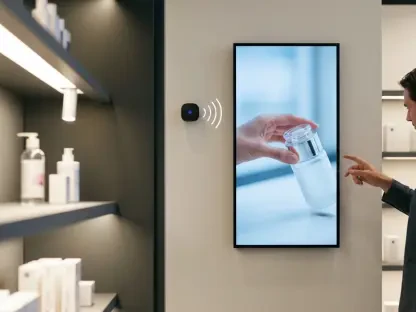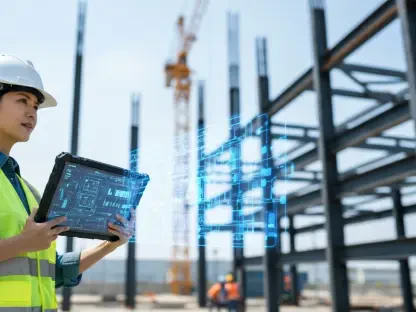The world of construction and development has evolved drastically over the last 100 years. With the introduction of technology, the building process has become more efficient, cost-effective, and safe.
Building Information Modeling (BIM) and the Internet of Things (IoT) have emerged as essential technologies for construction and engineering teams. This powerful combination of tech stacks allows for seamless collaboration and a more efficient construction process.
Let’s examine the benefits of BIM and IoT for the construction industry and how automation can improve the building process.
How BIM and IoT Work Together
BIM and IoT are shifting the world of construction and development. Used to improve design, construction, and operations, these technologies reduce costs and enhance efficiency and service delivery.
Building Information Modeling gives architects a detailed overview of building structures before breaking ground. This information is used to draft plans accurately. With IoT, teams can map out building systems in advance, including heating, ventilation, air conditioning (HVAC), and electrical outlets. These insights are also valuable to maintenance teams, who can monitor systems in real time and proactively make fixtures. This increases efficiency and building safety.
The Benefits of Combining BIM and IoT
There are several benefits to incorporating BIM technology into construction. From process efficiency to site safety, these tools enhance the construction process. The benefits include:
Improved safety
Environment, Health, and Safety are the first considerations when taking on a construction project. BIM and IoT provide significant insights that can be used to improve site safety. With detailed digital visuals, project leaders can locate and identify potential hazards before they arise on-site. Since they can visualize the planning site in advance, there is more time to ensure that the environment is safe before breaking ground.
Increased productivity and delivery speed
By combining the power of BIM and IoT, construction and engineering teams are able to collaborate and work concurrently. BIM enables teams to pinpoint and rectify design issues long before they become a costly and time-consuming problem later down the line. IoT sensors provide monitoring capabilities which are used for equipment and process oversight. This is also beneficial for improving productivity and delivery speed.
Organized scheduling
Another benefit, attributed largely to BIM, is the ability to plan a construction project and schedule the process from start to finish. With insights into the site and infrastructure, and sensors to monitor the ongoing process, site managers can appropriately schedule the hiring of plant equipment, accurate supplies, and allocate hours for labor. Inclement weather conditions stall approximately 45% of all construction projects globally. With IoT devices, project managers can accurately forecast weather conditions and schedule construction activities within the windows of opportunity.
Lower risk and reduced costs
BIM is incredibly useful in mitigating risk in construction and development projects, and reducing the associated costs. First, by breaking down silos on a project, the risk of miscommunication leading to project complications and delays is immediately reduced. If the architect needs to make material infrastructural changes, the updates to the BIM 3D model are immediately available to all teams.
This means that any changes in delivery date, material supply, and equipment required can be accounted for in real time. BIM’s accuracy in creating models to scale is also useful; contractors can make accurate estimates about supply volumes and the likelihood of facing issues like running out of building material is lessened. Again, this has cost implications and allows for better management of the project budget and cash flow.
From an IoT point of view, risk and cost reduction can largely be attributed to optimizing resources and predictive maintenance. The use of sensors on construction sites provides real-time data, which enables accurate decision-making. A good example of this is the process of curing cement. With sensors, project managers can monitor the process and ensure the cement is ready, which saves time on rework.
The Evolution of Automation in BIM
With the rapid development of technology, BIM and IoT tools are increasingly more connected and can automate more processes with every iteration. But these tools weren’t always embraced by the industry.
The earliest examples of BIM first surfaced in the 1970s as a platform called a Building Description System. It wasn’t until the 1980s, and significant development into the technology, that the US started to consider the adoption of BIM, which would really take off in the 2000s.
Construction projects in the US today rely heavily on BIM technology. Research shows that 100% of large sized architecture firms (and 33% of smaller firms) use BIM tools.
Integrating Data Exchange for Increased Efficiency
The Internet of Things has a wide array of applications in several industries, with a focus on improving efficiency and streamlining processes. This is achieved through connecting devices and systems. In the construction industry, this data exchange can be useful for enhancing smart product design. IoT is able to connect multiple data sources which can enable a more accurate design process.
Previously, the required information would have to be sourced from across a number of tools like BIM or CAD, but with IoT they’re able to integrate the various components and create a seamless design.
IoT also provides the added benefit of real-time analytics. Sensors, connected to assets, capture data which allow users to monitor these assets in real time. This information can then be used to optimize operations or make informed decisions about future investments. In short, by integrating data from diverse sources into a single platform, project managers can achieve increased efficiency and cost savings in many areas of a construction operation.
Concluding Thoughts
The construction industry has undergone enormous changes to keep pace with the demand for industrialization. With new technology like Building Information Modeling and the Internet of Things, construction teams have greater oversight of building infrastructure, from planning to execution.
By combining BIM and IoT, the various teams that contribute to a finished product can better collaborate. BIM systems provide deep insights into the planning phase, allowing architects to draft accurate plans based on real-time data.
With IoT, they can accurately plot the points for building systems, and once installed, maintenance teams can use these systems to plan services in advance. BIM and IoT can improve safety, reduce costs, and enhance efficiency in the construction industry while facilitating seamless collaboration between the various on-site teams.









